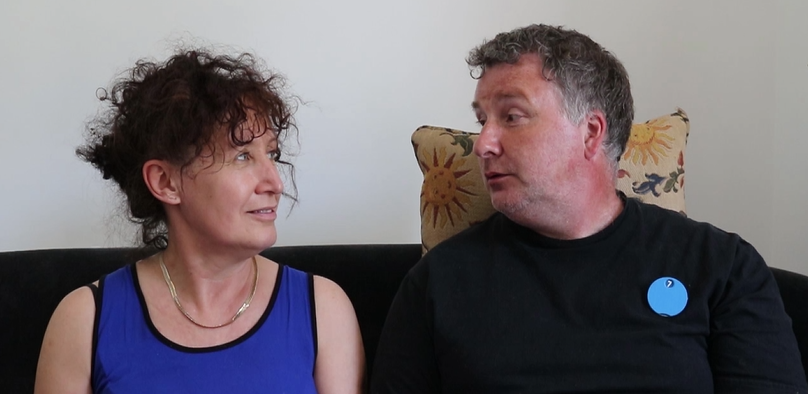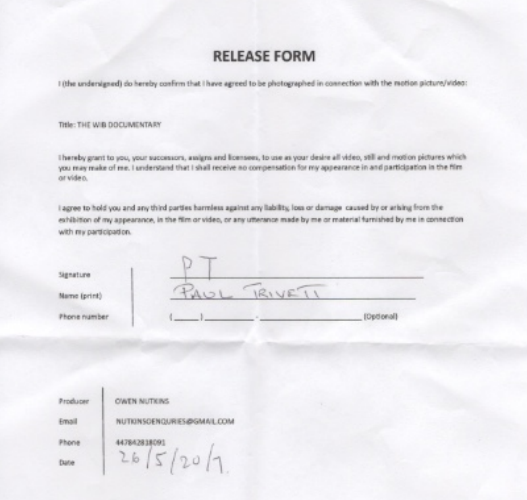PROPOSAL & PRE - PRODUCTION
- OWEN NUTKINS
- Oct 17, 2017
- 6 min read
This journal contains all the pre-production that I have taken out & will take out during this project, showing the planning process from the start to end.
PRE-PRODUCTION
''Work done on a product, especially a film or broadcast programme, before full-scale production begins''
PURPOSE
After taking a documentary out in my first year as my final major, its allowed me to understand the type of shots and also the ways that I need to take things out in a different way, fixing & approving upon the mistakes and errors I had last time. And because this project is rather different from my last documentary, I feel it sets a challenge and something that interests me into finding out, also with the fact of my second year documentary not working out, I feel that's really given me a percentage of motivation to complete it & I've now understood what has went wrong in the process.
I want the story to follow, the users of the invention that Alan created, as this was huge part of the previous recording, I want to be able to tell the story in the way that im involved & interested in connecting with these people as much as Alan has & his invention. The story will follow how they feel about the invention & how easy they find it to use & if they would suggest it to others.
The documentary will aim to be around 5-8 minutes, with additional filming to take a maximum of two weeks - following further interviews & standard filler shots, where it follows the stories & lives of the interviewees. The overall project will be rather slow paced in the sense the interviews move from each other, giving enough time for the interviewees to explains their views, & for myself to explain the stories & process of what's happening using a voice over.
RESEARCH
Research has been a huge benefit to developing my ideas to how this production will happen, I decided to directly look at similar documentaries, that follow the same type of style or story line. I picked these because of how detailed & how related they would be to my production & that is something I want to convey when taking out my documentary.
I took a look into a film called ‘’Living With The World's Most Painful Disease | MSNBC '' on what they explore, a person's illness that is in sense invisible to everyone else, to explain & showcase the pain but also the way she gets around it, while sharing others stories too. I found this video really inspiring & that’s something I’d personally like incorporate & take on into my documentary.

WHO & WHY? (CONTACTS)
For my contact research it hugely laid on who Alan was already providing his tool too, & in this case a few people already was in use with his invention, the plan was to visit them & for them to tell their stories of how it's help them & it can help others.
So firstly Alan himself is a main contact in this production.

Alan who is a strategic consultancy partner to leaders and organisations in transformation at Reality Check Consultancy, also apart of the RSA.
Inventor of the WIB

Alex & Triv, a user of the WIB for stroke Aphasia - after his stroke his speech as become harder & harder and with that Alan introduced the WIB to him, he is now one of the early users of the WIB (Well being indicator badge)

Meera - A user of the WIB after Chronic heart transplant rejection, alongside other illness's.
Both of these people use the WIB in order to help themselves & others & with that we hope to interview them to tell their stories & views on the WIB it self.
LOCATION - WHERE & WHY
The location will vary, from client to client however Alan bases in Bristol where majority of the filming will take place, alongside Alex & Triv living their, where as Meera living up in London.
(Further research and locations decided will be featured in the next blog)
THINGS I HAVE TO CONSIDER
LIGHTING - Is the biggest thing to consider for any film, I will need to make sure the lighting, is good enough to be able to record all the shots with a constant lighting scale. This will most likely involve having a external lighting source outside of natural lighting.
TRANSPORTING OF EQUIPMENT – Locations & transporting are important, depending on where I decide to shoot, say its in college or at home. I am going to need a way to transport all the equipment to and from, for example, camera's, tripods and lighting will be most important.
FOOD/WATER - Depending on the time and location, food & water is something I will consider, if I’m working with a team or alone, I must be able to keep myself-motivated to work and full up with energy on working times, so either bringing food with or making sure there are local shops near will help, this is something that comes into pre-production however I mostly will bring food along with me,
COMMUNICATION - Is important for any film shoot, if this is for calling in for more equipment or contacting people you are working with, since I will most likely be filming at home, I will have full access to internet & 3G if I need to contact anyone.
EMERGENCY - On the top of emergency, I will also make sure my location has resources on location to help anyone who is hurt; this could be water, a plaster or whatever else I will need.
KIT
Kit always comes into the whole production process, in my case I have to think about what I will need but also what I can carry around with me from location to location.
Canon 750D's - This will be the main camera I use to take out the interviews.
One tripod, this will provide a steady camera for the interview process & allow me to get the certain angles that I want to get.
Tascam – The Tascam is a possible extra item that I will bring along for extra backup in case the camera audio fails.
Canon 550D – This is my personal camera & it will be used as a backup camera, alongside a behind the scenes camera, where I will use it to film & take photos of what’s happening, that I can use within my journal entries.
EDITING SOFTWARE/EFFECTS IDEA’S
Editing will take place over at least 2-3 weeks giving me enough time to layout a story, edit down into something basic & then fully edit it – leaving enough time to hopefully visit it again, cut & tidy it up fixing it down to the very small errors. The editing process will take place in college & possibly outside of college allowing me all the time I will need.
MOOD BOARD

Creating a mood-board is very important because it brings everything together in forms of images. I firstly present the images that show the certain techniques I may possibly use throughout my production.
I also listed Music, music is something that improves the overall production and idea of any film, it brings out the emotions of the film, if be happy or sad - Although i don't directly showcase what music i will be using, i listed it to show music will be used, the music overall will be focused upon a inspirational tone to where it will also be informative
Shortly after that i present locations, to show the different area's and tones of each recording session.
Lastly I list the type of shots I will be using, as listed, I will directly be focusing at close ups and medium shots - The close up with directly focus upon the detail on the interviews but also filler shots for medium style shots.
STORY BOARD
FILM RISK PRODUCTION
Having a production risk assessment helps because not only can I underline the possible problems or issues that may come up, I can easily underline solutions to them, even without visiting the site before hand, I can easily think of possible issues or hazards that may be caused by equiment or the possible surronding location.

RELEASE FORMS
Having the release forms, is just something re-assuring to have, to know that I have their permission to post the video out once completed and that they are happy in taking part in the production.














Comments